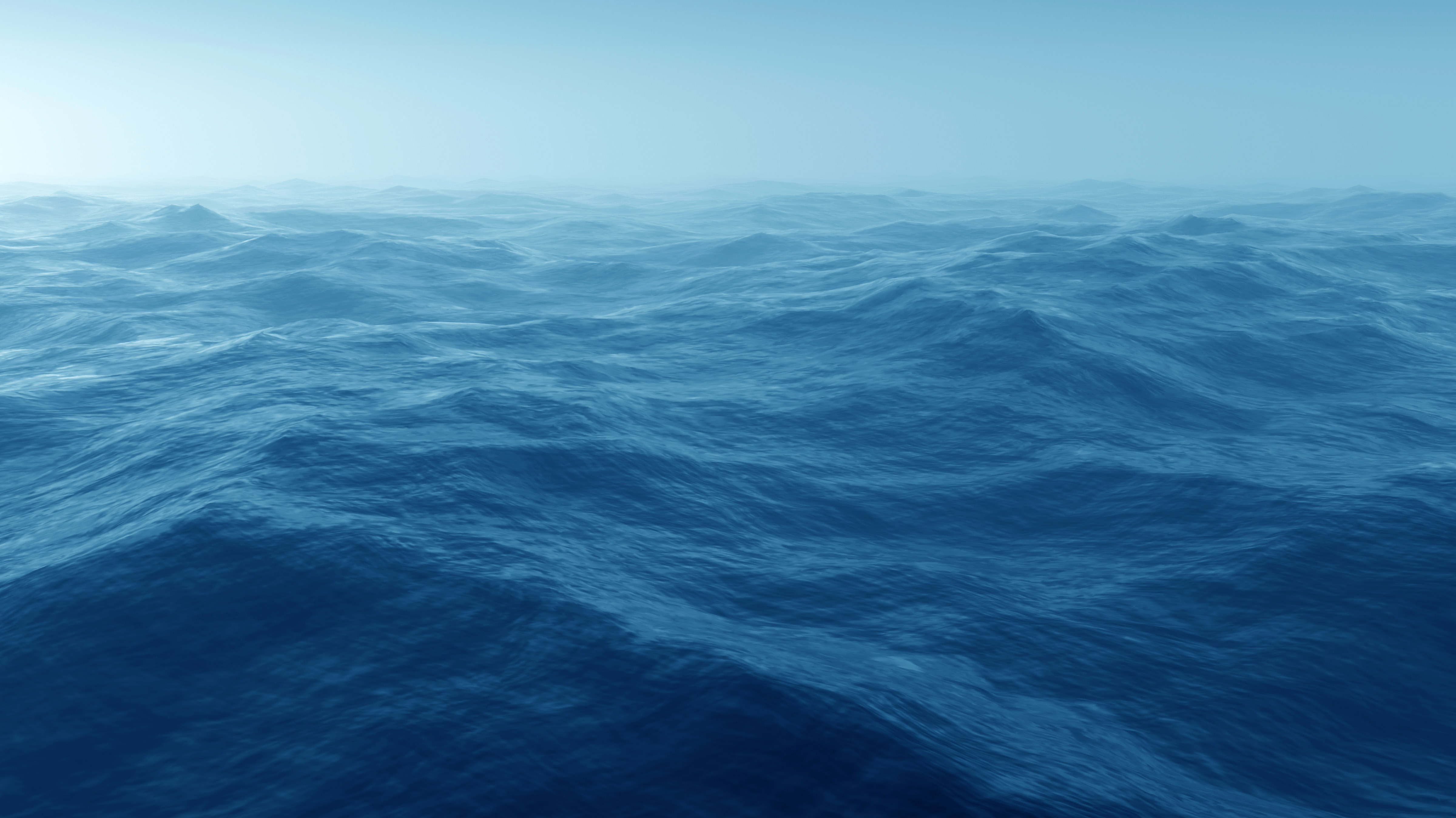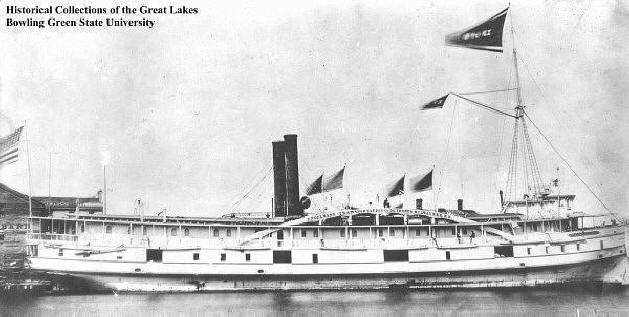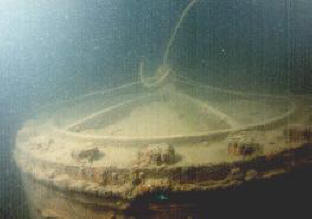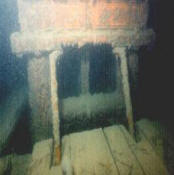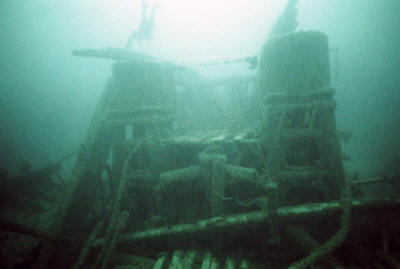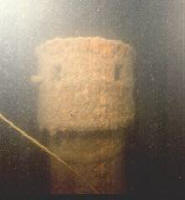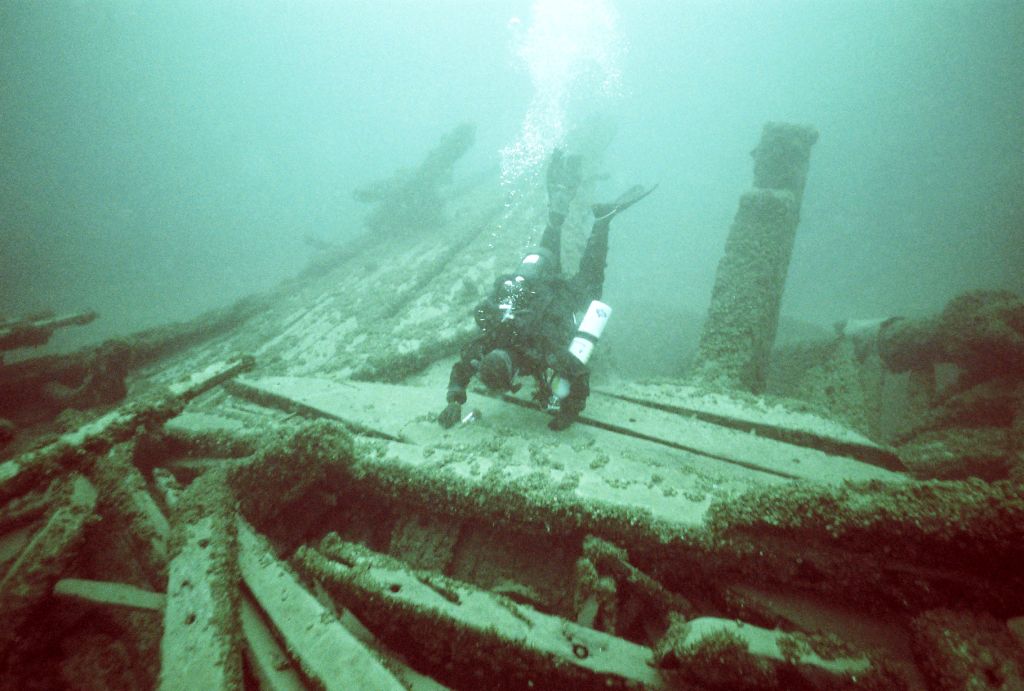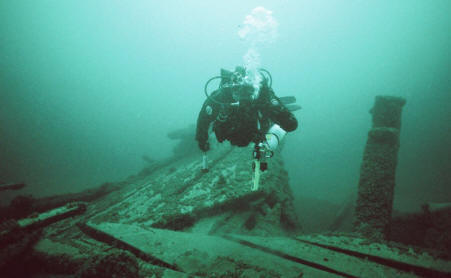N 43° 02.898′, W 086° 19.146′, Straight off Grand Haven harbor,120′ deep
The Ironsides was launched on July 23, 1864 in Cleveland, Ohio. Built by Ira Lafrinier and owned by the Lake Superior Line, she was a comfortable and roomy passenger steamer. The 1,123 ton, wood hull steamer was 218 feet long at the keel and 231 feet long overall, with a beam of just over 30 feet and was distinguished by hogging arches running along both sides. She had a passenger deck over a single cargo deck with a pilot house at the stem. Enrollment papers stated she had “a plain stem and a round stern”.
Her machinery was built by the Cuyahoga Iron Works in Cleveland and consisted of two direct-acting engines — called “Jack and Jill” by the crew — with 34 inch cylinders and a 42 inch stroke which drove two four-bladed propellers at her stern. Twin smokestacks rose prominently above the decks, just aft of amidships. Previous articles and books also have raised questions about her name, since the Ironsides was launched as a wooden hulled vessel. Documentation has revealed that her entire hull may have been metal plated. Remnants of rusting metal plates can be seen on numerous areas of the hull.
Author David D. Swayze, who maintains a “Great Lakes Shipwreck Database” has provided the following Detroit Free Press article published shortly after the Ironsides‘ launching in 1864.
THE NEW STEAMER IRONSIDES
“Detroit Free Press, September 21, 1864 –This magnificent steamer made her appearance yesterday morning, at the foot of Woodward avenue, and in a short time was visited by a large number of our citizens, who, having already heard much of the superiority of her structure were anxious to see for themselves. It occupied but a few minutes of time to satisfy one and all that the whole was a splendid achievement, and the IRONSIDES a grand success. There may be some points as regards other model that do not come up to the eye of some mechanical judges, but we failed to see them ourselves, nor did we hear the like expressed by others. The shape is what is termed an easy model – faultless – her water lines splendidly drawn, which gives the boat a graceful and majestic appearance.
The IRONSIDES was built by Quayle and Martin, of Cleveland, whose renown as shipbuilders has a world-wide prominence. Her length of keel is 219 58-100 feet – over all 231 feet. Breadth of beam 31 28-100 feet, over all, including guards, 38 feet. Depth of hold 14 38-100 feet, registering 937 tons. She is constructed of the choicest material, and in point of strength it is impossible that anything more substantial can be accomplished. She has two water-tight bulkheads, and the hull supported by massive arches that are secured by uprights, all of which is heavily ironed. All the necessary paraphernalia for saving life, such as life boats, of which there are more than the usual number; the security from fire, with every other precautionary measure for the safety of the passengers, has been most faithfully carried out. The interior arrangements of her cabin are superb and of a magnificent character, and are not excelled in any part of the world. The furniture is of the most costly kind – the floors covered with beautiful Brussels carpeting – the state-rooms with elegant damask curtains, and the interior of the cabin lighted with splendid chandeliers.
She has forty-four state-rooms – many of them convertible at will to family rooms, all furnished to a nicety. In the extreme forward of the boat may be found the wash-rooms fitted up with marble, with warm or cold water always at hand. There is also the bath room – hot or cold, with various other etceteras, which we failed at the time more particularly to note. Two fine paintings also adorn the cabin, one at each extreme end – the forward represents the Sault Rapids with the surrounding scenery, the other the old frigate Ironsides rendering relief to a burning British vessel. Her cabin is free of any encumbrance its entire length, which adds much to the grandeur of the arrangements.
The propelling power of this splendid craft are by no means to be passed by. The designs and drawings of her engines were got up by J. F. Hollaway, Esq., a resident of Cleveland , and a brief view of the department is sufficient to satisfy the closest observer that this gentleman’s scientific attainments are of no mean order. We visited and inspected this department both above and below decks, and can truly say for their simplicity, superior workmanship and the admirable mode of moving the same, they are unrivaled. They were got up by the Cuyahoga works, under the efficient management of W. B. Castle, Esq. Her boilers are of superior construction – 21 feet long, 10 feet diameter, having in them 378 return tubes. Her wheels are of the Philadelphia pattern, 9 feet diameter and of solid build. Her facilities for discharging and taking on cargo, as well as other working apparatus are all, in themselves, complete and need no improvement.
It is not to be expected that this splendid craft, so beautifully and comfortably arranged, accompanied by so many improvements heretofore unknown, has been brought to such perfection without some mastermind at the head of the whole minutia. To Captain J. E. Turner, her commander, all this may be attributed, who, for many years in the Lake Superior trade, has been enabled to study closely and minutely what is most desirable for the comfort and convenience of the thousands who travel that way. The captain may feel proud that he has triumphed in his long cherished hopes, and has lived to see the same carried into perfection. The officers of the Ironsides are: Captain, J. E. Turner; First officer, Geo. Cleveland; Second Officer, James Madison; John Holland, purser; First engineer J. E. Merrill; Second engineer, J. Barker; Steward, J. T. Hanison.”
The Ironsides was operated out of Cleveland, Ohio with major ports of call on Lake Superior, Detroit, and Mackinac Island. In 1869, the Ironsides and her sister ship Lac La Belle, were sold to the Engleman company of Milwaukee, Wisconsin. At that time she was switched to the Milwaukee to Grand Haven, Michigan run — providing direct connection between the two ports and, most importantly, their respective railroad terminals.
On October 14, 1872, the Lac la Belle sank off Racine, Wisconsin after leaving Milwaukee for Grand Haven, Michigan. Her sister ship would suffer a similar fate exactly eleven months later. During the winter of 1872-1873, the Ironsides was given a thorough overhaul and was pronounced in excellent condition. This adds to the mystery. The Ironsides would be on the bottom of Lake Michigan by mid-September, 1873.
On September 14, 1873 the Ironsides left Milwaukee at 9:45 pm with 19 passengers and a crew of about 30. The ship’s cargo consisted of 13,000 bushels of wheat, 500 barrels of flour, 125 barrels of pork and assorted general merchandise. A moderate southwest breeze was blowing. Before dawn, however, a full gale was howling across the lake and the Ironsides was laboring so hard that she began to take on water. Captain Harry Sweetman tried twice to bring the ship through the Grand Haven channel to safety, but to no avail. Each time the ship would miss the channel, she would have to be swung around in the huge waves and headed back out for another attempt.
At the time, it was reported the ship “narrowly missed going on the beach”. We now believe the ship did “bottom out” on the beach during this fierce battle as six of her eight propeller blades show significant damage. No doubt her bottom was also damaged allowing even more water to enter the hold. Contemporary reports say she “settled down stern first, her bow remaining in sight a full minute.” The propellers show damage on six of eight blades, indicating they were turning at great speed when damaged. They could not have been turning when she sank since the ship’s boilers were out. Reports say Captain Sweetman aborted the third try and backed the vessel away from shore to ride out the storm . We believe the damage was already done.
Despite the efforts of the pumps, the fires under her boilers soon were extinguished, allowing the ship to roll helplessly in the trough of the waves. By 9:00 am the ship started sinking. The Ironsides‘ machinery was now useless and a flag of distress was run up the mast. At about 11:00 am, five lifeboats were put over the sides and all passengers and crew made it safely away from the sinking ship. As the custom dictated, Captain Sweetman was the last to leave his doomed vessel. The Ironsides slipped beneath the waves of Lake Michigan about 3 miles off the Grand Haven coast at 12:10 pm.
Of the five lifeboats, only two reached shore. The other three were capsized by the surf. Despite the efforts of local residents — who formed human chains to sweep up survivors — and the newly organized volunteer lifesaving service crew, under the capable leadership of Captain Richard Connell it is believed about 20 lives were lost that day. The newspaper listed eleven passengers lost along with ten crew. It also named nine passengers saved as well as 23 crew saved. This however adds up to more than the 49 people known to be aboard at the time.
Ships porter Peter Riley stated “I took charge of the third boat which left the steamer. There were 13 in the boat including Maggie, the chambermaid. Our boat did not capsize. All aboard were saved but one, and that was Mr. Wimmel a new York traveling agent as he and Mr. Dundasher, the cook, were washed overboard. Mr. Dundasher swam in all right but Mr. Wimmel seemed exhausted and made no effort to save himself.”
The dead included Captain Sweetman, Chief Engineer Robert Mc Glue and steward John Driscoll. The newspaper stated, “the ladies of Grand Haven took charge of the bodies and saw them properly coffined.” The Engelman company furnished coffins for all bodies not provided for by family or friends. The ship was valued at $80,000 with cargo valued at $28,000.
In 1878, pieces of the wreck were brought up in fishermen’s nets. In 1887, 14 years after the sinking, the Engelman Transportation Company announced a plan to raise the vessel, but no attempt actually was made.
In about 1966, diver Gene Turner, well known local wreck hunter, located the Ironsides exactly where the old newspaper accounts said she was — in 120 feet of water, 4 miles west-southwest of Grand Haven. He is reported to have recovered various equipment from the ship including a trunk containing cobblers tools and a trunk of civil war uniforms, costumes and wigs, thought to have belonged to a theatrical troupe.
The Ironsides lies flat on the bottom in 120 feet of water. The highest point — the top of the cylinder heads — is another 10 feet higher. Her superstructure and passenger decks are gone. The forward half of the vessel is split open and largely missing. The arches are intact, although both have fallen inward and one is cracked while the other has a small break in it. Storms in 1998 and 2001 have further damaged the wreck.
The boilers, firebox and cylinder heads are intact but the ship’s steering mechanism at the stern is no longer standing. The unusual rudder configuration is unlike most others of the era. The twin screws are still in place, although damaged severely. Scattered around the wreck site are various pieces of pipe and machinery. At least one of the twin smokestacks is reported to have been sighted just southwest of the main wreckage. A large piece of wall or roof, approximately 12 by 35 feet lies along the port side on the lake bottom.
